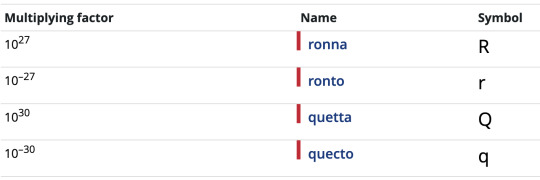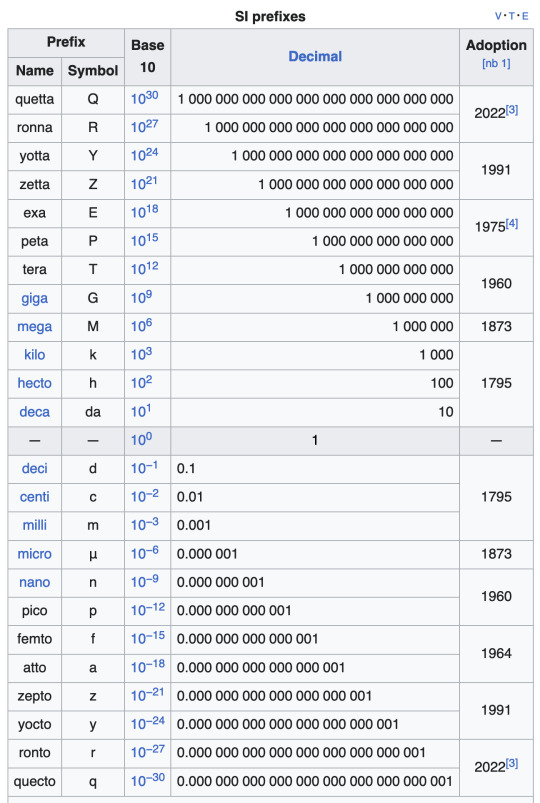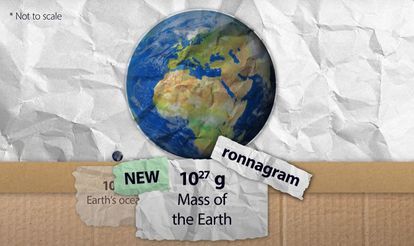#quecto
Text
Remember when 10^27 was unofficially called "hella" in California, for ages?
Last year, SI passed a resolution to officially define the following prefixes:

What's particularly funny is that they specifically mention that this is done considering "the importance of timely action to prevent unofficial prefix names being de facto adopted in other communities".
Source / Licence
0 notes
Text

There's not a lot of things that need measuring to this extent, but in 2022 the International Bureau of Weights & Measures officially adopted four new prefixes: ronna- and quetta- on the large scale, ronto- and quecto- on the small. For context of how intense these measurements are, the entire observable universe is a few yottameters short of a ronnameter, while a single hydrogen atom is about half a nanometer, or five hundred quintillion quectometers.
93 notes
·
View notes
Text
metric system: we have the meter and a few dozen metric prefixes from quecto- to quetta-, which is more than enough to measure everything from the smallest elementary particles (1 yoctometer) to the diameter of the visible universe (just under a ronnameter). also water freezes at 0 degrees and boils at 100. simple
imperial system: yeah so we have inches, feet, yards and miles. 0 degrees is "cool" and 100 degrees is "hot". our system is better because its more intuitive and comprehensible for the layman. idk i just don't like the idea of a nice ordered system of length and temperature measurement where everything is easily convertible through simple multiplication/division by a power of 10
#this is not a call to start using metric units in everyday life btw#more of a rant about ppl who argue the imperial system is better basically because its less nerdy#those silly internet argument peoples#lost in their quarrels and no longer aware of the beauty of metric units (if they ever were)
4 notes
·
View notes
Text
okay okay okay it's time for the work in progress comprehensive autism special interest list and the ages at which they happened. very much for my own records but like, feel free to read and be like "wtf" if you want. tldr how did nobody pick up the autism
memorised all metric prefixes for every scale of measurement up to / down to yocto and yotta when I was 9 (new prefixes were defined in 2022 yay they are ronna, quetta, ronto, quecto for 10e27, 10e30, 10e-27, 10e-30)
related to above: spent all my free time in year 4 looking at scale of the universe 2
spent all of high school telling everybody about how the time derivatives of position could be extended indefinitely and some of them have cool / stupid names like snap crackle and pop (which I also had memorised in order)
watched every vsauce video before bed every night for like 4 years straight, I must have seen each video at least 150 times by now
related to above: could recite vsauce video scripts and knew exactly what music was playing in the background at any given time in one of his videos
related to above above: made myself cry thinking about Big Theta ™️ in his video on infinity because I was like holy shit inaccessible cardinals are so cool (I still cry every time)
decided I wanted to try an astrophysics project in year 6 because the class projects were too boring, and dedicated a weekend to learning all the required trigonometry (that is, the entire high school trig curriculum)
tried (and failed) to solve navier stokes in year 5, turns out you probably need calculus for that
parents took me (toddler) to an observatory and insisted on paying full price for my ticket because they knew I would ask an absurd amount of questions
decided (as a toddler) I needed to become an astronaut so I could kick pluto back into the solar system
3 notes
·
View notes
Text
When I graduated with a degree in physics, the biggest and smallest SI prefices were ‘yocto’ and ‘yotta’. Now, because the total amount of information available to humans is growing so quickly, we've had to expand upwards to ‘ronna’ and ‘quetta’. It's only the physicists love of symmetry that has given us ‘ronto’ and ‘quecto’.
I have 47 yoctobytes of Star Trek :D .
#Système International#SI units#SI prefixes#you may not like my plural of ‘prefix’#but i don't care 😛#always a linguist at heart
1 note
·
View note
Text
As I’m writing this it’s the 6th anniversary of the last leap second, and the 10th anniversary of the xkcd What If? post about leap seconds.
Let’s just say things have changed since I last made a post here. On the weekend of November 19-20, two ominous changes happened to the world of universal standards. For one, four new metric prefixes have been made official: ronna-, quetta-, ronto-, and quecto-, for 10^27, 10^30, 10^-27, and 10^-30 respectively. This work seems to have been accomplished without even considering any of the numerous unofficial proposals that come up when googling “unofficial SI prefixes”, effectively rendering them outdated despite their prevalance in number names.
Well, at least “hella” for 10^27 didn’t become official. That was one of the most popular proposals, but to me it sounds very primitive compared to the Greek and Latin-based roots of the other prefixes, and doesn’t even sound like a word for nine!
But I’m not here to talk about SI prefixes, I’m here to talk about the leap second. At the very same conference that decided the metric prefixes, the CGPM voted to make leap seconds optional starting 2035. [1]
Wait, what? Isn’t the ITU in charge of deciding the fate of leap seconds, you say, not CGPM? And didn’t they defer the decision until their meeting in late 2023?
It turns out that the ITU also gave CGPM permission to decide the fate of the leap second in lieu of them. [2] The reason we didn’t hear about this earlier was beacuse everyone expected CGPM to be as slow and bureaucratic as ITU. As the Nature article says:
The CGPM's involvement is unlikely to mean a decision on whether to scrap the leap second will come sooner than 2023, however: the organization's next chance to even propose a change would not come until 2018.
Haha, that sure aged...
But there’s more. Apparently the wording of the proposal states that UTC “is allowed” to diverge from UT1 (the time standard determined by Earth’s rotation) by more than 0.9 seconds (the currently imposed limit), not that it has to if the earth slows down or speeds up. In fact, the CGPM merely proposes to add no more leap seconds for a century starting 2035. I’m not usually one to end on a pessimistic note, but given the influence of large corporations and other big-ticket donors on the decision, the chance of another leap second happening after 2035 currently seems grim.
Also, even though ITU allowed CGPM to make the decision, there was no formal process of transfer [2], which means that ITU could theoretically override the vote [1] and continue to implement UTC with leap seconds. However, this also seems unlikely.
I think we need a version of Hofstadter’s Law concerning the arrival of leap seconds. Hofstadter’s Law, formulated by computer scientist Douglas Hofstadter, says “It always takes longer than you expect, even when you take into account Hofstadter's Law.” Similarly, we can define the Law of Leap Seconds as “any future prediction related to the leap second is going to be disproven in an unexpected way, even if the predictor understands the Law of Leap Seconds.”
This was the case with the ITU’s decision in 2015, the surprisingly early leap second in 2016, the surprising lack of any leap seconds from then onward, and now the CGPM’s decision one year earlier than planned.
Well, at least one thing I said in 2015 aged well. I said that I would be active again in 2023 if Tumblr was still around by then. We can’t be sure yet because there are still a few hours of 2022 left in my time zone, but it seems very likely that Tumblr will still exist by 2023 and I will be here to report on what the ITU will decide at their meeting next year.
0 notes
Text
Ronna, ronto, quetta and quecto, the new prefixes for extraordinary magnitudes
Ronna, ronto, quetta and quecto, the new prefixes for extraordinary magnitudes
Ronna, quetta, ronto and quecto are incorporated as prefixes in the International System of Measurements (SI).NPL (Europe Press)
Every day more data is generated on digital media than all the information stored in the history of humanity until 1970. If all the current number of bytes (common unit of storage made up of eight binary digits (0 and 1) or bits) on stacked compact discs, the tower…

View On WordPress
0 notes
Text
Nuovi numeri che ci avvicinano all'infinito meno uno
Ronnabyte e quettabyte, i nuovi nomi per i numeri giganteschi. Aggiunta resa necessaria dalla crescita vertiginosa dei Big Data.
Ronnabyte e quettabyte sono i due nuovi nomi aggiunti al Sistema internazionale di unità di misura (Si) per descrivere le quantità gigantesche di dati che saranno presto prodotte nell’era dei Big Data: dopo lo yottabyte, che sta per 10 alla 24esima byte, una quantità di dati che richiederebbe una pila di dvd alti fino a Marte, avremo ora il ronnabyte (10 alla 27esima) ed il quettabyte (10 alla 30esima), come si legge in un'analisi online sul sito della rivista Nature.
Per simmetria, all’altra estremità della scala sono stati introdotti anche due nuovi prefissi per descrivere quantità estremamente piccole: ronto e quecto, che stanno rispettivamente per 10 alla -27esima e 10 alla -30esima. Per dare un’idea, 1 ronnagrammo sarebbe all’incirca il peso della Terra, mentre un elettrone è pari a 1 quectogrammo.

Ronnabyte e quettabyte sono i due nuovi nomi per descrivere le quantità gigantesche di dati che saranno presto prodotte nell’era dei Big Data (fonte: Pixabay)
I quattro nuovi prefissi sono stati votati il 18 novembre scorso da rappresentanti dei governi di tutto il mondo, riuniti alla Conferenza generale sui pesi e sulle misure tenutasi fuori Parigi. Si tratta del primo aggiornamento del sistema dei prefissi dal 1991, quando l’aggiunta fu però resa necessaria per il campo della chimica, che aveva bisogno di poter esprimere numeri molto più piccoli.
La proposta di modifica, presentata da Richard Brown del Laboratorio nazionale di fisica del Regno Unito dopo un lavoro di cinque anni, si è resa necessaria anche perché iniziavano a circolare nomi informali per esprimere quelle quantità, come hellabyte e brontobyte. “Sono rimasto inorridito”, commenta Brown, “perché erano nomi del tutto non ufficiali”. In passato, termini nati in modo informale sono poi stati adottati dal Sistema internazionale, ma stavolta ciò non è stato possibile poiché i simboli associati a questi due nomi sono già utilizzati all’interno del sistema metrico per altri prefissi o altre unità di misura.
Adesso, dice Richard Brown, non sono rimaste altre lettere dell'alfabeto disponibili per nuovi prefissi, quindi cosa accadrà quando, e se, qualche campo scientifico riuscirà a spingersi a grandezze oltre quelle attuali, rimane una questione aperta.
Read the full article
0 notes
Text
Ronnagrams and quettameters: Scientists confirm new prefixes for large and small measurements
Ronnagrams and quettameters: Scientists confirm new prefixes for large and small measurements
Scientists have officially confirmed new prefixes to express the world’s largest and smallest measurements, from the unimaginably large to the infinitesimally small.
Joining the ranks of well-known prefixes such as kilo are ‘ronna’ and ‘quetta’ for the largest-defined numbers and ‘ronto’ and ‘quecto’ for the smallest.
Ronna is 1 followed by 27 zeroes – a billion billion billion – while quetta is…

View On WordPress
0 notes
Text
11.19.22 Headlines
WORLD NEWS
Climate Crisis: UN climate talks poised for deal creating disaster fund (AP)
“Negotiators say they have struck a potential breakthrough deal on the thorniest issue of United Nations climate talks, the creation of a fund for compensating poor nations that are victims of extreme weather worsened by rich nations’ carbon pollution.”
Science: New measures for size, as world’s people surpass 8 billion (AP)
“There’s the gargantuan “ronna” (that’s 27 zeros after the one) and its big brother the “quetta” – (that’s 30 zeros). Their ant-sized counterparts are the “ronto” (27 zeros after the decimal point), and the “quecto” (with 30 zeros after the decimal point) -- representing the smaller numbers needed for quantum science and particle physics. Brown presented the new prefixes to officials from 64 nations attending the General Conference on Weights and Measures in Versailles, outside of Paris -- who approved them on Friday.”
North Korea: Kim’s daughter unveiled at missile launch site (AP)
“North Korea has unveiled the little-known daughter of its leader Kim Jong Un at a missile launch site, attracting keen attention on a fourth-generation member of the dynastic family that has ruled North Korea for more than seven decades.”
US NEWS
US Congress: House GOP pushes Hunter Biden probe despite thin majority (AP)
“But the midterm results have emboldened a White House that has long prepared for this moment. Republicans secured much smaller margins than anticipated, and aides to President Joe Biden and other Democrats believe voters punished the GOP for its reliance on conspiracy theories and Donald Trump-fueled lies over the 2020 election.”
Homelessness: California governor set to release $1B for homelessness (AP)
“California Gov. Gavin Newsom agreed to release $1 billion in state homelessness funding he testily put on pause earlier this month, but only if local governments agree to step up the aggressiveness of their plans going forward to reduce the number of unhoused people in the state.”
Twitter: Risks fraying as engineers exit over Musk upheaval (AP)
“Elon Musk’s managerial bomb-throwing at Twitter has so thinned the ranks of software engineers who keep the world’s de-facto public square up and running that industry insiders and programmers who were fired or resigned this week agree: Twitter may soon fray so badly it could actually crash.”
#current events#news#climate change#climate crisis#global warming#united nations#science#north korea#united states#gop#us congress#biden#homelessness#california#twitter#elon musk
1 note
·
View note
Text
Ronnametres and quettagrams have joined the ranks of SI units
https://sciencespies.com/physics/ronnametres-and-quettagrams-have-joined-the-ranks-of-si-units/
Ronnametres and quettagrams have joined the ranks of SI units
New prefixes in the International System of Units have been confirmed, ushering in ronto and quecto for tiny numbers and ronna and quetta for very large numbers, like the amount of data on internet servers
Physics
17 November 2022
, updated 18 November 2022
By Alex Wilkins
So much data is produced on the internet that we are running out of words to describe the magnitude
Erik Isakson Photographics/Digital Vision/Getty Images
New prefixes for the world’s largest and smallest numbers have been confirmed by a vote at the General Conference on Weights and Measures (CGPM) in Versailles, France, on Friday. The suggested prefixes are ronna and quetta for very large numbers and ronto and quecto for very small ones.
The International System of Units (SI) is a standard, agreed on by most scientists, that underpins every measurement. As well as defining things like the kilogram and the metre, it sets how very large and small numbers should be named.
The last expansion to this naming scheme was in 1991, when numbers with 21 or 24 zeros were given the prefixes zetta (1021) and yotta (1024) for the very large and zepto (10-21) and yocto (10-24) for the very small. There were few reasons to use them at the time, but the growing amount of data generated by the internet makes them more useful now – the amount of information is projected to hit 175 zettabytes by 2025.
Advertisement
“There’s already been quite a bit of speculation in the popular media about what could come above a yottabyte,” says Richard Brown at the National Physical Laboratory, the UK’s measurement standards centre.
For instance, brontobyte has been informally used by some to describe 1027 bytes, while Google’s unit converter has long changed 1027 bytes into a hellabyte. But these don’t fit with the SI naming scheme, because the letters “b” and “h” are already used for prefixes or are in common use for other units, says Brown, so adopting a standard now will ensure that alternative prefixes don’t get too deeply embedded in the scientific literature.
Brown helped draft the proposal that the CGPM member states voted for on Friday. As there were no objections, the two new prefixes for numbers with 27 and 30 zeros became, respectively, ronna and quetta for large numbers, and ronto and quecto for small numbers.
Although they will become SI prefixes with immediate effect, it might take a while for scientists to adopt them in their work.
Some scientists are sceptical of whether they will be helpful at all. “We tend to define our own units, which are just useful in terms of the things we are actually looking at,” says astronomer Mike Merrifield at the University of Nottingham, UK.
Brown suggests that ronto and quecto could have uses in radio astronomy, such as for measuring the very weak strength of the cosmic microwave background, radiation left over from the big bang, but astronomers already frequently use the non-SI jansky for this, says Merrifield.
However, the benefits for science communication are clear, says Brown. “You’re going to be able to communicate what you mean a lot better if you use these standardised approaches.”
While the names may seem random, they adhere to tight guidelines, says Brown. “R” and “q” were the only letters left in the English alphabet that hadn’t been used by other prefixes, the middle of the words were loosely translated from the Greek or Latin term for how many times you need to multiply 1000 by to get to the numbers, he says, and the endings were because large prefixes always end in “a”, while small prefixes finish in “o”.
As for when we might see even larger or smaller prefixes, Brown thinks we will be waiting at least 25 years. “It’s very difficult to predict the future, but I suspect that this will certainly see me out, I imagine, for my retirement and longer.”
More on these topics:
#Physics
0 notes
Text
Joining the ranks of well-known prefixes like kilo and milli are ronna and quetta for the largest numbers—and ronto and quecto for the smallest.
Since the SI was established in 1960, scientific need has led to a growing number of prefixes. The last time was in 1991, when chemists wanting to express vast molecular quantities spurred the addition of zetta and yotta.
"If we think about mass, instead of distance, the Earth weighs approximately six ronnagrams," which is a six followed by 27 zeroes, Brown said
Gigachad<<<Ronna Romney McDaniel
0 notes
Text
0 notes
Text
今年登場する新しい数え方「クエタ」や「ロント」は誰がどう決めた?
https://news.yahoo.co.jp/articles/fe04ac71b78e438b2136b6524bbf4f8c89e267b2
前回の記事「ギガより大きい1クエタ、ナノより小さい1クエクトは何桁の数字?」(https://gendai.ismedia.jp/articles/-/93180)でご紹介したように、今年、2022年は、「大きな数」と「小さな数」を表す言葉がそれぞれ2つずつ、計4つが新たに加えられる予定です。
「ゼタ」や「ヨタ」、「ゼプト」や「ヨクト」が追加された前回から、31年ぶりのことです。
新たに加わる4つとは、大きな数では10の30乗を示す「クエタ(quetta)」と10の27乗を示す「ロナ(ronna)」、小さな数では10のマイナス27乗を表す「ロント(ronto)」と10のマイナス30乗を示す「クエクト(quecto)」です。
今回は、…
View On WordPress
0 notes
Text
You know kilo, mega, and giga. Is the metric system ready for ronna and quecca? | Science
By the 2030s, computer system information storage might go beyond 1 yottabyte (1024), the biggest number with an authorities metric prefix.
UWE MOSER MOSER/ALAMY STOCK PICTURE
Fresh from redefining the kg and other basic procedures, the guardians of the metric system have actually set their sights on another upgrade: brand-new prefixes for insanely big and little numbers.
A proposition lodged with the International Bureau of Weights and Steps (BIPM) in Paris suggests brand-new names—ronna and quecca—as prefixes for 1027 and 1030, respectively. They would be signed up with by their tiny equivalents, ronto for 10−27, and quecto for 10−30. If authorized, the brand-new terms might be officially presented in 2022. They would be the very first prefixes included because 1991.
The prepared upgrade reacts to the huge development in international information storage, which by the early 2030s is anticipated to reach 1 yottabyte (1024)—the top of the existing scale. Without brand-new prefixes, computer system researchers will have no other way to formally speak about what follows. At the other end of the scale, quantum physicists have actually determined atomic forces as little as 42 yoctonewtons. Much smaller sized and they lack metrological roadway.
“Where there is a need that is not met, there is also a risk that unofficial units can take hold and that can cause confusion,” states Richard Brown, head of metrology at the National Physical Lab near London, who developed the brand-new names. He states informal terms beyond yotta, consisting of brontobyte and geobyte, are currently ending up being popular. Although mathematicians in some cases utilize the prefix googol (10100), a name created a century back by a 9-year-old woman, it, too, is informal.
Brown chooses to follow custom. The brand-new prefixes ought to relate etymologically to 9 and 10, to represent the ninth and 10th powers of 103. He likewise wished to continue the reverse alphabetical pattern set by zetta and yotta, however required to prevent letters such as X, W, and V that might be puzzled with other terms. Therefore, drawing from the Latin and Greek words for 9 (novem, ennea) and 10 (decem, deka), with some poetic license to make the terms more quickly noticable, he developed ronna, quecca, ronto, and quecto. “It’s supposed to be a conversation starter,” states Brown, who released his proposition last month in the journal Measurement.
An entire lotta yottas
Metrologists are proposing to extend metric prefixes beyond yotta and yocto.
Prefix Sign Power quecca Q 1030 ronna R 1027 yotta Y 1024 zetta Z 1021 exa E 1018 peta P 1015 tera T 1012 giga G 109 mega M 106 kilo k 103 milli m 10–3 micro μ 10–6 nano n 10–9 pico p 10–12 femto f 10–15 atto a 10–18 zepto z 10–21 yocto y 10–24 ronto r 10–27 quecto q 10–30
The terms are because of be talked about at the October conference of BIPM’s Consultative Committee for Systems. If the committee authorizes the concept, it might make an official suggestion to BIPM. The company’s basic conference, that includes federal government agents and is because of next fulfill in 2022, would have the last vote—as it did late in 2015 when it approved a new definition of the kilogram based upon basic physical constants.
It’s prematurely to state whether the prefixes will be embraced, states Estefanía de Mirandés, executive secretary of the systems committee and a physicist with BIPM. “It would be premature to mention a possible outcome of the discussion,” she composed in an e-mail.
Other propositions to extend the measurement scale have actually fizzled. In 2010, a physics trainee in California recommended “hella” as a prefix for 1027, and countless individuals signed an online petition in assistance. (Contrary to reports, the concept did not reach the BIPM systems committee for official conversation.) In 2008, a short article in The New York City Times on supercomputers described a xeraflop, and a 2015 paper on cosmic engineering utilized the signs X, W, and V to explain the colossal energy levels, beyond the yotta scale, that might be seen if aliens turned a black hole into a particle accelerator. One prankster hacked a Wikipedia short article in 2008 to present a brand-new technical term for a computer system that might try 1048 operations per second: a gonnaflop. It lasted 7 minutes prior to being erased.
Ronna, quecca, and their partners might fare much better. Emilio Prieto, who represents the Spanish Metrology Center in Madrid on the systems committee, states he would vote for the names due to the fact that they are easy and unforgettable. “Once people start using the wrong prefix names it is impossible to go back,” he states.
If those 4 are authorized, Brown states, just a single great letter would stay that might be utilized by itself for 1033 and 10−33 in future: B (and b). Brown currently has names at the ready: bundecca and bundecto, based upon the Latin for 11, undecim.
New post published on: https://livescience.tech/2019/02/14/you-know-kilo-mega-and-giga-is-the-metric-system-ready-for-ronna-and-quecca-science/
0 notes